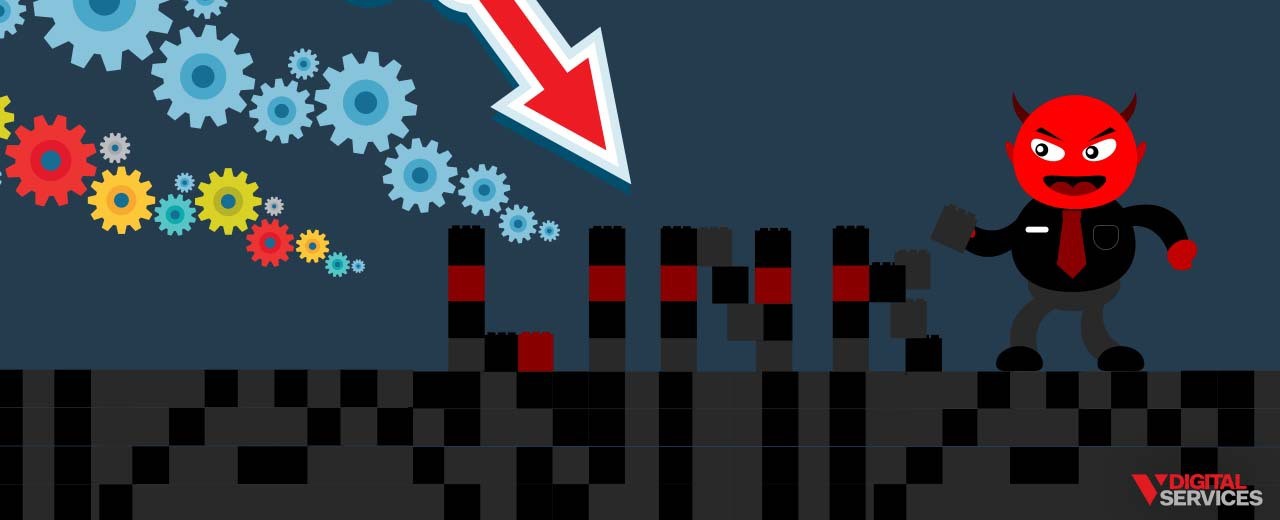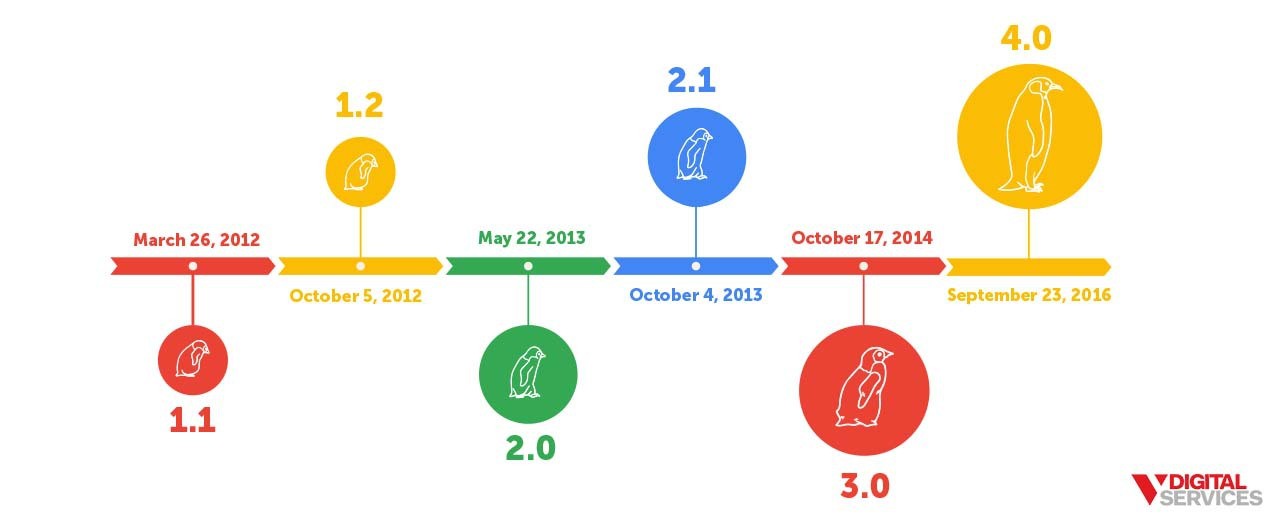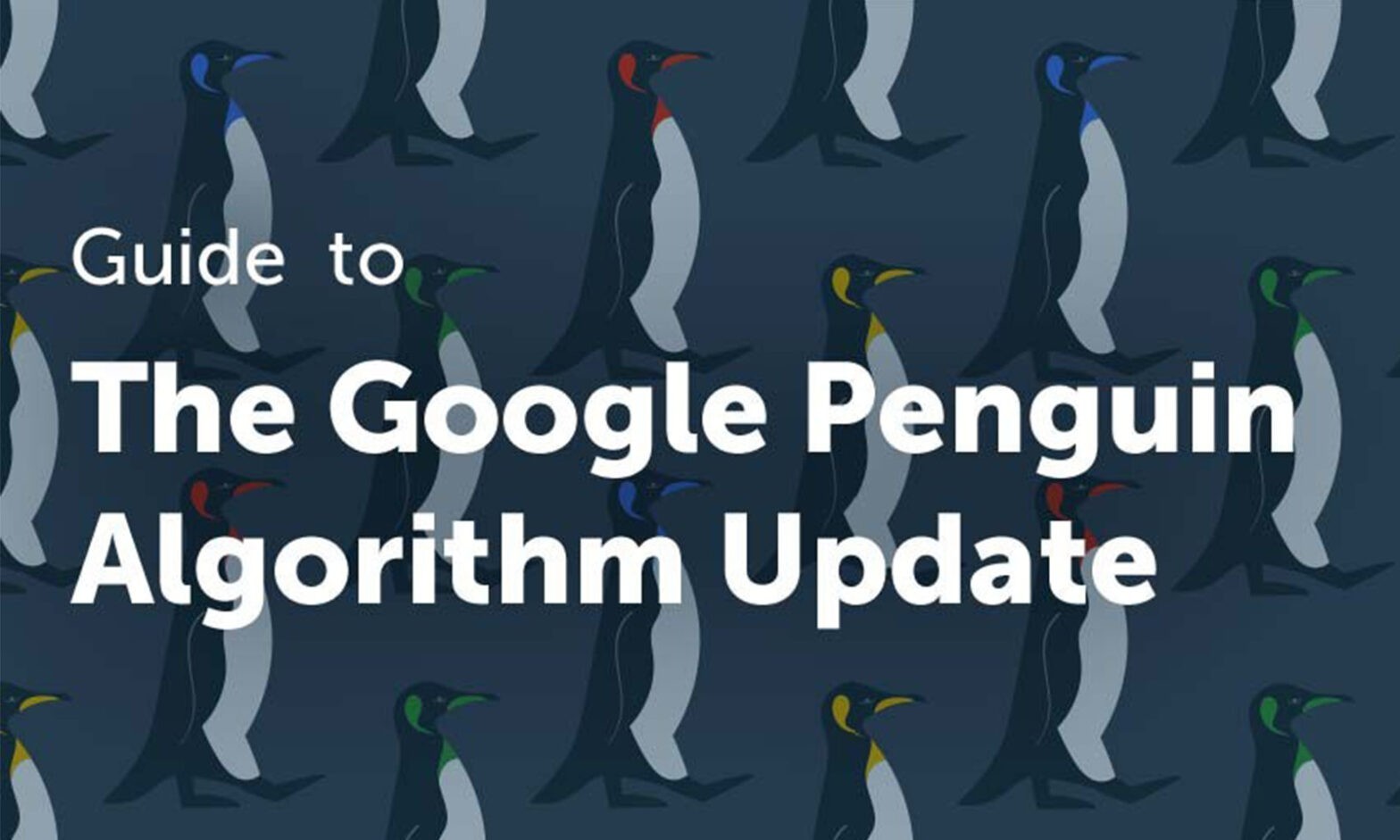Nearly a decade ago, Google debuted a major update to their algorithm, aiming for manipulative link-building practices and link spam – and the rest, as they say, was history.
Officially known as the Google Penguin Update, the webspam algorithm forever changed the way websites are ranked by Google. Before it was released, link volume was a key factor in scoring a page after being crawled, indexed, and assessed by Google.
Unfortunately, this methodology created a major loophole: low-quality content and webpages were able to secure better organic search results rankings than they deserved, simply due to high link volume.
As you can imagine, the imbalance of quality in the search rankings was something Google wanted to fix quickly. In keeping with their commitment to delivering the best possible user experience – and of course, relevant, useful search results – Google’s webspam team got to work, and the Penguin update was born.
We’ve created a comprehensive guide that covers everything you’ve ever wanted to know about the Penguin Update from Google, condensing nearly 10 years of Internet history (pun intended) into a single, easy-to-read resource.
We’ll be looking at the what, why, and how of Penguin and diving into the practical strategies you need to make the algorithm work for you.
 Why was the Google Penguin Update Created?
Why was the Google Penguin Update Created?
In the early days of the Internet, spammy content, keyword stuffing, and other black hat SEO tactics were everywhere.
And even though you can still find all of that online today, it’s been better relegated to the sidelines of search – and we largely have the Penguin update to thank.
Google first started tackling low-quality web pages with their Panda algorithm update. Later, Penguin was introduced as an extension.
Penguin was Google’s weapon of choice against the rampant black hat link-building techniques that were being used to influence search results and rankings. Even though Panda had made a dent in the massive pile of spam, Penguin was designed to go even further. Ultimately, Google’s goal was to disarm the users implementing black hat spamming tactics by focusing on the types and quality of earned backlinks.
With the update to their search algorithm, Google gained the ability to better process the various types of links that webpages and webmasters were earning and implementing in their content. As a result, the algorithm rewarded web pages with high-quality, relevant, and authoritative links while penalizing those relying on spammy linking methods.
It’s important to note that Penguin was specifically engineered for sites’ incoming links only, no outgoing links.
The Initial Impact of Google’s Penguin Update
When Penguin was first launched (April 2012), Google estimated that it had a noticeable effect on more than 3% of global search results. Just over a year later, Penguin 2.0 was released as the fourth update to the Google algorithm.
That update affected just over 2% of search queries.
For the sake of context, Panda significantly impacted about 12% of all search queries.
 A Timeline of Google Penguin Updates and Algorithm Refreshes
A Timeline of Google Penguin Updates and Algorithm Refreshes
Anyone that’s worked in SEO will tell you that updates to the Google algorithm stick to a fairly steady pace, which is largely why search works as well as it does today. For Penguin, in particular, there have been a fair number of updates and refreshes in the almost-10 years since its debut.
Of course, it can be hard to stay on top of all the updates and what they mean for your web page, especially if you aren’t an SEO expert. But don’t worry because we’ve rounded up the most important changes to Penguin and organized them into a brief history of algorithm updates.
Google Penguin 1.1
March 26, 2012
Technically, Penguin 1.1 was a refresh of the data within the algorithm, not a change. The updates’ effects were two-fold: the websites affected by the initial launch were able to see a certain level of recovery if they had worked to revamp their link profiles. For many websites that had seemingly escaped penalty in the first round, this update proved to have an impact.
Google Penguin 1.2
October 5, 2012
In this second data refresh, search queries in both English and international languages were affected.
Google Penguin 2.0
May 22, 2013
Penguin 2.0 was a step forward for the algorithm on a technical level, directly changing the way the algorithm ranked search results. The first update went beyond a website’s homepage and top-level category pages, working to pinpoint evidence of spammy links on multiple levels.
Google Penguin 2.1
October 4, 2013
Penguin 2.1 marked the only time Penguin 2.0 received a refresh, though the exact purpose behind 2.1 mainly stayed behind the closed doors of Google. Experts have theorized that the data refresh continued Google’s efforts to crawl webpages on a deeper level and allowed more intensive analysis of the containment of spammy links.
Google Penguin 3.0
October 17, 2014
Another update, another step forward in the elimination of widespread black hat link tactics. Websites that were impacted by previous updates were able to make progress on recovery (assuming they had cleaned up their acts). This update extended Google’s reach and delivered penalties for other sites that had continued their low-quality link-building methods.
Google Penguin 4.0
September 23, 2016
Nearly two years after 3.0, the final algorithm update for Google Penguin was released. Easily the most news-worthy part of the launch was Penguin becoming a permanent part of Google’s core algorithm.
Even though that didn’t mean the actual functionality of the algorithm was changing, this did mark a shift in how Google perceived the algorithm itself.
Presently, Penguin runs in tandem with the core algorithm to assess links and webpages in real-time. This translated to the new ability to observe how your link building or cleanup efforts affected your search rankings, almost to the minute.
Unlike the previous versions of Penguin, which took a punitive approach to deal with websites using low-quality and spam links, 4.0 instead downgraded the value of the links themselves.
But that doesn’t necessarily mean that penalties no longer exist – it’s certainly still possible to see your rankings take a hit if you try black hat tactics.
How Do the Algorithm Downgrades of Google Penguin Work?
Not long after the introduction of Google Penguin, brands and webmasters that had relied on manipulative or low-quality backlinking strategies started to see their organic rankings and traffic decline. The downgrades weren’t necessarily applied to an entire side; rather, some targeted specific keyword groups had been dramatically over-optimized.
Penguin also has the capability to move between multiple domains, so switching up the domain (in an attempt to redirect) isn’t an option. Various SEO experts and enthusiasts have experimented with the use of 301 and 302 redirects but have found that they aren’t an effective way to sidestep Penguin.
Typically, meta-refresh type redirects are to be avoided, regardless of Google Penguin. These can create problems for users and search engine crawlers alike, appearing as an attempted redirect.
Google Penguin 4.0 Recovery
After Google Penguin, many SEO experts were left asking: does the disavow tool help with algorithmic downgrades? The tool has long been a useful resource for SEO strategists and remains so even with Penguin incorporated in Google’s core algorithm.
Like many topics in SEO, there is some debate as to whether or not disavowing links can really help a website recover after a link-based downgrade or manual action. Google has publicly stated that disavowing does work but should be used primarily in combating link spam.
What should be included in a disavow file?
When you submit a disavow file to Google, you essentially communicate that the algorithm should ignore all included links.
As a result, you can free yourself from the negative ranking issues caused by low-quality links. However, it’s important to be very careful – if you accidentally include good links in the file, you’re losing the ranking boost they can offer.
No notes are needed in your disavow file, but you’re free to include them if they’re helpful for your reference. Because an automated system processes the files, none of your notations will be viewed.
The only content required in a disavow file is the list of links you request to be ignored.
After you upload the file, you can expect a confirmation of receipt from Google.
The file will be immediately processed, but recovery will still take time. The disavow file doesn’t direct Google to crawl the specific web pages you noted, so the full recovery is typically gradual.
When you check the linking report in your Google Search Console, you’ll still see the links, with no specification as to which have been discounted so far. That can make it a bit challenging to determine where your site is at in the recovery process.
If you have submitted a disavow file in the past, it’s important to be aware that a new disavow file replaces the original; it doesn’t add to it.
This means that you’ll always need to include previously disavowed links in each new file. The Google Search Console makes it easy to download the most current disavow file at any time, should you need to confirm any details.
What is the difference between disavowing individual links and disavowing domains?
Generally, it’s better to disavow on a domain level rather than working with individual links. There may be large websites with both quality and paid links in some situations, and disavowing individual links will be a better option.
But typically, a domain-based disavow is your best bet. Here’s why:
- For a link to be discounted on your website, Google only has to crawl a single webpage on the entire site.
- You don’t have to deal with links that are indexed as non-www or www because a domain-based disavow already considers this.
How to Find and Eliminate Low-Quality and Spammy Links
Although there are some cases in which webmasters and brands are intentionally using manipulative link-building strategies, your website can also accumulate bad links without you necessarily realizing it. If you’re noticing a disconnect between where you think your ranking should be and where it is, it may be time to conduct a link audit.
How to find backlinks to your website
On Google Search Console, a site owner can get a list of backlinks. However, the list will include “nofollow” links, which don’t have an impact on your site’s ranking.
But if the site removes the “nofollow” – which can happen without any warning – your site can be impacted.
You can also find various third-party tools for backlink auditing, though the tools’ bots are blocked from crawling certain websites for various reasons.
For example, many high-quality websites block these bots in order to preserve their bandwidth. But on the other hand, some spam sites also block the bots to keep their subpar links under wraps.
The result is that you may not be able to see a complete profile of all your backlinks, including both high- and low-quality pages.
Monitoring backlinks
Like any industry, SEO has a small number of disingenuous players who try to use backlinking to hurt their competitors. Negative SEO attacks happen when a brand or webmaster purchases spammy links, using them to direct to your website to downgrade your ranking.
Luckily, Google is generally capable of determining the difference between a negative SEO attack and a website that’s chosen to implement low-quality linking. So, you don’t need to spend too much time worrying about falling victim to this online “crime.”
For many reasons, taking a proactive approach to managing your backlink profile is a smart idea. Not only does it help you stay on top of potential issues, but it also demonstrates your website integrity when you utilize the disavow feature without a penalty or manual action is on the line.
In other words, it shows Google that you’re invested in maintaining a high-quality, authoritative backlink profile – and you’re doing it of your own volition.
Requesting link removal
When you find bad links, eliminating them can sometimes be as simple as reaching out to the site’s webmaster with removal requests. Sometimes, a site owner will ask you to pay a fee in return for the link removal, but Google advises against sending any form of payment. Instead, just include the relevant links in your disavow profile.
Link outreach can help your website recover from Google’s link-based penalties, but you don’t necessarily have to do it for every single spammy link. The Penguin algorithm assesses a website’s link profile as a whole, so a solid profile of high-quality links can help balance out a handful of spammy ones.
If you receive a partial penalty, which targets over-optimized keywords, the basics of maintaining and monitoring your backlinks can usually remedy any effects.
How to Know if a Link is High-Quality
There are plenty of links out there that are simply masquerading as reputable, high-quality sites – and unfortunately, it can be tricky to figure out which is which. Here are a few things to keep in mind when you’re determining the quality of a specific link:
- Don’t make the mistake of judging a link on its domain type alone. It’s impossible to label an entire category of domains as high-quality or low-quality, so you’ll need to look beyond that. For example, many people assume that links from .edu sites are automatically trustworthy, but that’s not always true. Just like any other domain, .edu sites can be spammy (and even hacked).
- Even if a link is from a well-known or major website, it’s not guaranteed to be a good link. There are plenty of popular websites that sell links (sometimes under the guise of advertising and sometimes when a contributor goes rogue).
- Understand which links can be categorized as paid links. Most people think of “paid links” as those involving some sort of money exchange, but Google goes one step further. If a promotional link was provided in return for a product review, discount, or even a gift, Google technically views it as a paid link. Even if you ran a promotional campaign several years ago, the negative effects could be hitting your website now. You’ll need to “nofollow” these links in order to repair the issue (you can still reap the benefits of traffic and brand awareness).
Ultimately, all of this means that individually assessing each and every link is a necessity for recovery. Making broad assumptions is a risky game because you can miss low-quality links and inadvertently remove good links.
What to Do if Your Recovery Efforts Don’t Work
So, you’ve invested the time and energy into cleaning up your backlinks – but you haven’t seen any improvement in your rankings or web traffic… what now? There are a few different reasons that recovery isn’t panning out the way you expected:
- You removed links but didn’t seek out new, higher-value backlinks to add to your profile.
- Any increase in your traffic or rankings before you were penalized was probably a short-term boost from bad backlinks.
- There are still many negative backlinks that have yet to be disavowed or removed.
- Your ranking issues weren’t related to links in the first place.
As you recover from a Penguin algorithmic penalty, your rankings aren’t going to immediately jump back to where they were before.
Even though it would certainly be a plus to start achieving top rankings for your desired search queries, that’s just not the reality of link-building (or SEO in general).
There are three key reasons why your rankings won’t necessarily be as high as they were previously:
- Your site’s original ranking may have been artificially inflated due to some of the links that you have now disavowed.
- It’s not uncommon for some good-quality links to be accidentally included in the disavowal process, so you could have eliminated some that helped your ranking.
- The Google ranking algorithm is constantly changing, as are the factors that can benefit search results rankings.
Common Misconceptions about Google Penguin
There’s no shortage of Google Penguin myths floating around the Internet, many of which have even experienced SEO strategists fooled. Sorting fact from fiction can get tricky, but we’re dispelling a few of the most popular myths surrounding Penguin now.
Misconception: The Penguin algorithm is a penalty.
Many people refer to Google Penguin as a penalty, or a “manual action,” imposed by Google. But actually, Penguin is solely algorithmic. This means that it can’t be enforced or lifted by Google on a manual basis.
While it’s true that both a penalty and a change to the algorithm can drop your rankings, there are important differences between the two:
- A penalty occurs when a Google webspam team member implements a manual action on a certain domain after responding to a flag report and conducting an investigation.
- You will be notified of the penalty via the Google Search Console.
- In addition to auditing your backlinks and disavowing spammy links, you’ll also need to submit a reconsideration request to the webspam team.
- If your efforts are successful, Google will revoke the penalty. If not, you will have to go back to auditing your backlink profile.
- A Penguin downgrade is an algorithm-based action, not something that involves an actual member of the Google team.
- You will not receive a notification if your website is affected by Penguin (more on that in a minute).
- Remedying backlink issues can result in a fairly speedy recovery because you no longer have to wait for a Penguin refresh or update for changes to take effect.
Misconception: Google sends you a notification when Penguin downgrades your ranking.
While the Google Search Console does inform you in the event of a penalty, you won’t be notified if/when the Penguin algorithm has been applied to your website. Constantly checking your SERP rankings is the best way to spot a position change so that you can act quickly.
Misconception: The only way you can reverse a Penguin downgrade is by disavowing all low-quality links.
It’s true that the disavowal tool can help clean up subpar links, but it requires a significant amount of time and effort. You don’t have to hunt down every bad link and disavow it because Penguin primarily focuses on the ratio of good links to spammy ones.
So, you can certainly attempt to wipe out at least some of the bad links, but increasing your number of high-quality links can often be more impactful.
Misconception: There’s no way to recover from Penguin.
It can often feel like a Penguin downgrade is something that will drag your site down forever. It is possible to recover – but time, experience, and a certain level of skill is required.
It’s no secret that Google algorithms can be fickle, which is why many brands decide to invest in professional SEO services for the best possible outcomes.
 Bounce Back from Google Penguin – and Stay on Top – with Help from V Digital Services
Bounce Back from Google Penguin – and Stay on Top – with Help from V Digital Services
At first glance, it might sound like Penguin 4.0 complicates the entire concept of rankings, but it really does set up a more even, fair playing field for everyone. With black hat link-building techniques becoming less and less of a viable option, savvy SEO strategies are earning the quality rankings they deserve.
Whether you need help starting an SEO strategy from scratch or you’re trying to figure out how to recover from a Penguin downgrade, the SEO experts at V Digital Services can help.
We’ll work with you to build a strong backlink profile based on quality, construct a technically sound site, and implement effective SEO tactics to achieve your ranking goals. With the right plan in place, you can see measurable results sooner than later.
For more information about how to navigate post-Penguin, connect with the V Digital Services team today!
Image Source: Yuliia Bahniuk / Sergey Korkin / erwin_wirapratama / Chuie / RoBird / Shutterstock


 PREVIOUS
PREVIOUS
Hello, dear Trevor Weitzel. Your algorithm article was excellent. Our team has also written an article about the Google Penguin algorithm on the .وب آینده website. We invite you to read our article. I am a fan of your website.
https://webayandeh.com/seo-tutorial/articles/google-penguin-algorithm/
Thanks
Mehdi Saravani
webayandeh site manager